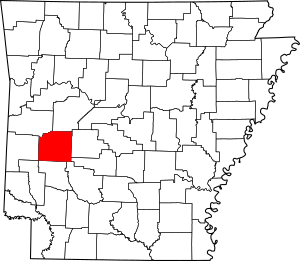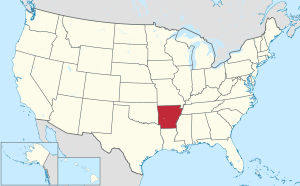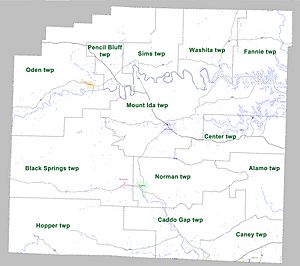Montgomery County, Arkansas facts for kids
Quick facts for kids
Montgomery County
|
|
|---|---|
|
Clockwise from top: Eagle Rock Vista in the Ouachita Mountains, the Norman Public Library, Quartz from a Montgomery County mine, the Little Missouri River, and the Montgomery County Courthouse in Mount Ida
|
|

Location within the U.S. state of Arkansas
|
|
 Arkansas's location within the U.S. |
|
| Country | |
| State | |
| Founded | December 9, 1842 |
| Named for | Richard Montgomery |
| Seat | Mount Ida |
| Largest city | Mount Ida |
| Area | |
| • Total | 800 sq mi (2,000 km2) |
| • Land | 780 sq mi (2,000 km2) |
| • Water | 20 sq mi (50 km2) 2.6%% |
| Population
(2020)
|
|
| • Total | 8,484 |
| • Density | 10.6/sq mi (4.09/km2) |
| Time zone | UTC−6 (Central) |
| • Summer (DST) | UTC−5 (CDT) |
| Congressional district | 4th |
Montgomery County is a county in the U.S. state of Arkansas. In 2020, about 8,484 people lived there. The main town and county seat is Mount Ida.
Montgomery County became Arkansas's 45th county on December 9, 1842. It was named after Richard Montgomery, a brave general from the American Revolutionary War.
Contents
A Look at History
People have lived in the Montgomery County area for a very long time. Stone spear and dart points show that early people, called the Dalton tradition, were here around 8500 BC.
Signs of old houses and American Indian burial grounds are found near Caddo Gap, Arkansas. This tells us that the Caddo Indians lived here in the 1200s and 1300s. In 1541, the explorer Hernando de Soto even fought the Tula tribe near Caddo Gap.
Early Settlers and New Beginnings
The first white settlers arrived in 1812. Martin and Mary Collier settled in what is now Caddo Gap. They got along well with the local tribes.
In 1835, Granville Whittington came to the area. He built a road from Hot Springs, Arkansas to his farm. By 1836, when Arkansas became a state, most Native Americans had left. Some Native American women had married local white settlers.
Whittington opened a general store that many people visited. In 1842, he opened the Mount Ida Post Office. West of the Ouachita River, some travelers stayed for the winter and decided to make it their home.
Becoming a County
Montgomery County was once part of the huge Louisiana Purchase. It was first claimed by Spain, then France. Later, it was part of Arkansas County and then Clark County.
On December 9, 1842, Montgomery County officially became its own county. The town of Montgomery was first chosen as the county seat. In 1850, Salem became the county seat for a short time. But later that same year, the county seat moved to Mount Ida, where Whittington's Post Office was. Mount Ida became an official town in 1854.
The Civil War Era
When the Civil War started, most people in Montgomery County supported the Confederacy. Men from Mount Ida joined the Confederate Army.
During the war, soldiers from both sides took supplies from homes and farms. This left many families with little food. After the war, soldiers from both armies settled in the area. They helped build schools and homes. In 1884, the town of Oden built a steam saw, a cotton gin, and a gristmill.
From Logging to Modern Times
Around the early 1900s, the Missouri Pacific Railroad arrived in Caddo Gap. This helped Caddo Gap and Black Springs grow. In 1910, the county's population was at its highest. Many sawmills opened.
The town of Womble was settled in 1910 and changed its name to Norman in 1925. A logging camp called Mauldin, Arkansas started in 1918. A railroad line was built to it from Norman. However, in 1936, Mauldin suddenly closed. The logging companies had cut down all the trees and moved on. This, along with the Great Depression, hurt the county badly.
Many people left to find work. Some found jobs with the Civilian Conservation Corps. During World War II, more people left. Men went to war, and others found jobs in war factories. Mining, especially for quartz, was a job for a while, but it didn't last.
In 1922, Montgomery County had 83 school districts. Today, there are only three: Caddo Hills, Mount Ida, and Ouachita River. Now, raising cattle, swine, and chickens are the main jobs in the area.
Geography of the County
Montgomery County covers about 800 square miles. Most of this area, about 780 square miles, is land. The rest, about 20 square miles, is water.
Main Roads
 U.S. Highway 70
U.S. Highway 70 U.S. Highway 270
U.S. Highway 270 Highway 8
Highway 8 Highway 27
Highway 27 Highway 88
Highway 88
Neighboring Counties
Montgomery County shares borders with these counties:
- Yell County (north)
- Garland County (east)
- Hot Spring County (southeast)
- Clark County (southeast)
- Pike County (south)
- Howard County (southwest)
- Polk County (west)
- Scott County (northwest)
Protected Natural Areas
Part of the Ouachita National Forest is located in Montgomery County. This is a large area of protected land.
Population and People
| Historical population | |||
|---|---|---|---|
| Census | Pop. | %± | |
| 1850 | 1,958 | — | |
| 1860 | 3,633 | 85.5% | |
| 1870 | 2,984 | −17.9% | |
| 1880 | 5,729 | 92.0% | |
| 1890 | 7,923 | 38.3% | |
| 1900 | 9,444 | 19.2% | |
| 1910 | 12,455 | 31.9% | |
| 1920 | 11,112 | −10.8% | |
| 1930 | 10,768 | −3.1% | |
| 1940 | 8,876 | −17.6% | |
| 1950 | 6,680 | −24.7% | |
| 1960 | 5,370 | −19.6% | |
| 1970 | 5,821 | 8.4% | |
| 1980 | 7,771 | 33.5% | |
| 1990 | 7,841 | 0.9% | |
| 2000 | 9,245 | 17.9% | |
| 2010 | 9,487 | 2.6% | |
| 2020 | 8,484 | −10.6% | |
| 2023 (est.) | 8,620 | −9.1% | |
| U.S. Decennial Census 1790–1960 1900–1990 1990–2000 2010 |
|||
In 2020, there were 8,484 people living in Montgomery County. Most people living there were White (about 88%). Other groups included Native American, Asian, and people of mixed backgrounds. About 5% of the population was Hispanic or Latino.
Towns and Communities
Here are the main places where people live in Montgomery County:
Cities
- Mount Ida (This is the county seat)
Towns
Census-Designated Places
These are areas that are like towns but are not officially incorporated as cities or towns.
Other Small Communities
- Alamo
- Caney
- Center
- Fannie
- Hopper
- Sims
- Washita
Townships
Counties in Arkansas are divided into smaller areas called townships.
Famous People from Montgomery County
- Osro Cobb (1904–1996): He was a politician who served in the Arkansas House of Representatives. He also worked as a U.S. Attorney.
- Lon Warneke (1909–1976): He was a professional baseball pitcher. He played for famous teams like the Chicago Cubs and St. Louis Cardinals. He was born in Mount Ida.
Images for kids
See also
 In Spanish: Condado de Montgomery (Arkansas) para niños
In Spanish: Condado de Montgomery (Arkansas) para niños








